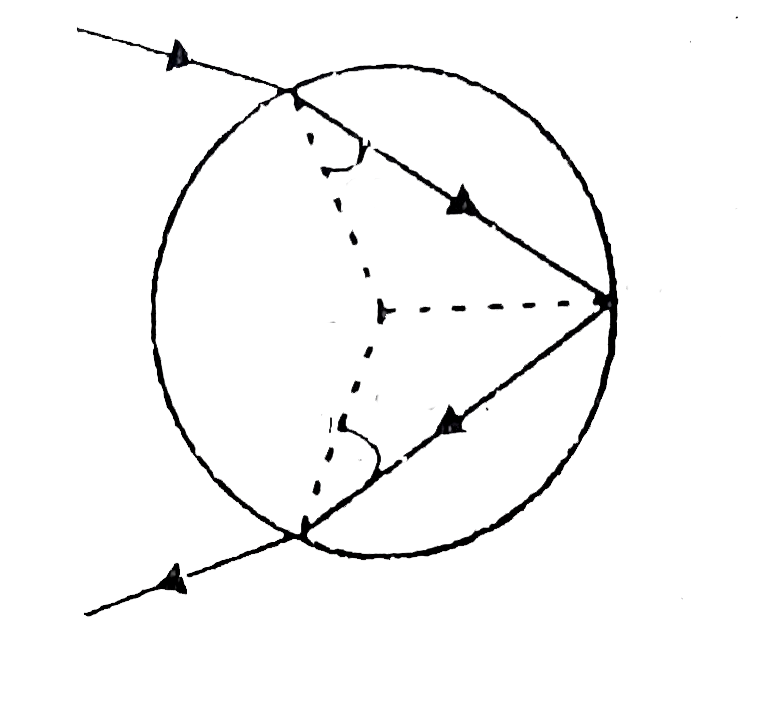If two prisms are combined , as shown in figure, find the total angular dispersion and angle of deviation suffered by a white ray of light incident on the combination.

Both prisms will turn the light rays towards their bases and hence in same direction, Therefore turnings caused by both prisms are additive.
Total angular dispersion
=θ+θ'=(μV−mUR)A+(μ'V−μ'R)A'
=(1.5−1.4)4∘+(1.7−1.5)2∘=1.8∘
Total deviation
=δ+δ'=(μV+μR2−1)A+(μ'V+μ'R2−1)A'=(1.5+1.42−1)0.4∘+(1.7+1.52−1)0.2∘
=(1.45−1)0.4∘+(1.6−1)0.2∘
=0.45×0.4∘+(1.6−1)0.2∘
=0.4×0.4∘+0.6×0.2∘
=1.80+1.2=3.0∘
Topper's Solved these Questions
- GEOMATRICAL OPTICS BOOK - RESONANCECHAPTER - GEOMATRICAL OPTICS EXERCISE - Problem
33 Videos
- GEOMATRICAL OPTICS BOOK - RESONANCECHAPTER - GEOMATRICAL OPTICS EXERCISE - Exercise-1
142 Videos
- EXPERIMENTAL PHYSICSBOOK - RESONANCECHAPTER - EXPERIMENTAL PHYSICSEXERCISE - PART -II
10 Videos
- GRAVITATIONBOOK - RESONANCECHAPTER - GRAVITATIONEXERCISE - HIGH LEVEL PROBLEMS
16 Videos
Similar Questions
Two thin prisms are combined such that they neither produce any average deviation nor do they cause any dispersion when white light is incident on the combination. Angle of one prism is A=2° and refractive index of its glass for red, yellow and violet lights are 1.49, 1.50 and 1.51 respectively. Find the dispersive power of the glass of the other prism.
View SolutionFind the angle of deviation suffered by the light ray shown in figure. The refractive index mu = for the prism material.

View Solution
Knowledge Check
The angle of a prism is 60∘ and its refractive index is √2. The angle of minimum deviation suffered by a ray of light in passing through it is
AAbout 20∘B30∘C60∘D45∘The angle of a prism is 60∘ and its refractive index is √2 . The angle of minimum deviation suffered by a ray of light in passing through it is
AAbout 20∘B30∘C60∘D45∘A ray is incident on the first prism at an angle of incidence of 53∘ as shown in the figure . The angle between side CA and B'A' for the net deviation by both the prisms to be double of the deviation produced by the first prism , will be
_E01_086_Q01.png) Asin−1(2)3+53∘Bsin−1(2)3+37∘Ccos−1(2)3+53∘D2sin−1(2)3
Asin−1(2)3+53∘Bsin−1(2)3+37∘Ccos−1(2)3+53∘D2sin−1(2)3
A ray is incident on the first prism at an angle of incidence 53∘ as shown in the figure. The angle between side CA and B'A' for the net deviation by both the prisms to be double of the deviation produced by the first prism, will be:

View Solution
A ray is incident on a sphere of refractive index √2 as shown in figure. Angle of refraction of the ray inside sphere is 30∘ if total deviation suffered by the ray is 30x0, then find x.
View SolutionA ray of light PQ is incident on the face AB of an equilateral glass prism ABC as shown in the figure. Show that angle of emergence = angle of deviation. Also, with a ray diagram, trace the path of the emergent ray.

View SolutionDraw the path of light ray passing through a prism. Label angle of incidence and angle of deviation in the ray diagram.
View SolutionA ray of light is incident on a prism as shown in fig. Find the total deviation suffered by the ray if ∠BAC=1∘ and ∠CAD=2∘.

View Solution
